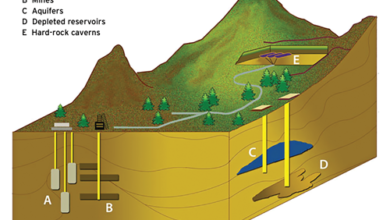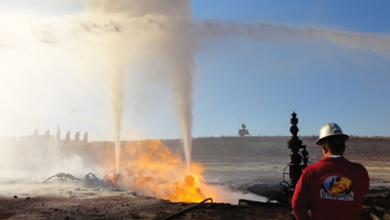Drilling & Completion Tech Digest
YPF deploys Tenaris connection for two Argentina wells

Tenaris recently deployed its TenarisHydril Wedge XP threaded and coupled connection for YPF in the San Jorge and Neuquén basins in Argentina. The operator was seeking cost-efficient solutions for two wells where it was using drilling with casing technology.
The operator decided to run a production casing string with 5 1/2-in. 17-lb K55 TenarisHydril Wedge XP connection with an operative torque of 17,685 ft-lb. In the San Jorge Basin, YPF drilled 1,703 m with a running performance of 3/4 min for the complete joint makeup, conducting the operation with zero re-makeups and rejects. During the operation, the weight on bit (WOB) reached up to 14 tons, with a torque at surface that increased up to 14,500 ft-lb. In this well, YPF also achieved a record depth for its drilling with casing operations in the San Jorge basin. In the Neuquén basin, the operator drilled 360 m. The WOB reached up to 6 tons, and the connection withstood a torque of 7,500 ft-lb.
BP enhances digital rocks program with addition of multiphase flow simulation technology
BP is adding multiphase flow simulation technology to its digital rocks program. The operator announced on 2 May a multi-year agreement with Exa Corp that aims to enhance BP’s ability to predict the flow of oil and water in digital images of reservoir rock. Innovations like this have played a crucial role in the company’s ability to significantly reduce its breakevens over the past two years, Ahmed Hashmi, BP’s Head of Upstream Technology, said at the 2017 OTC. “Approximately 75% of the cost savings that we have brought into our portfolio are sustainable in nature. Technology is playing a big part in this,” he said.
BP established the digital rocks program 10 years ago. The technology takes rock core samples acquired during the drilling and images the samples with ultra-high resolution CT scans to create a 3D digital model of the rock. The model is then put through proprietary algorithms that simulate the physics necessary to characterize the rock properties.
The ability to digitally analyze rock properties eliminates the need to perform physical tests on the rock, Dr Joanne Fredrich, BP Upstream Technology Senior Advisor, said. “We can generate a suite of rock properties in a matter of a few days to a couple of weeks, as compared to in the laboratory, where it might take us over a year to make all of these physical measurements on the rock core,” she said. Additionally, the digital rocks technology can perform its analysis using a small, thumbnail-sized piece of rock that can be acquired at a lower cost.
To date, BP’s technology has analyzed only the rock’s static properties, not its dynamic properties. To address this gap, the operator worked with Exa to develop a relative permeability software solution. The solution was adapted from Exa’s existing multiphase fluid flow simulation technology, which was originally developed for the automotive and aeronautics industries.
The new multi-year license agreement between BP and Exa allows BP to utilize the relative permeability software within the digital rocks platform, enabling the operator to better predict the flow of oil and water in digital images of reservoir rock. “With this technology, we can fully characterize the range of rocks in the reservoir and build better subsurface models and predict and understand the reservoir performance. It’s a game-changer for us,” Dr Fredrich said.
New LWD solution provides formation density and dip information in subsalt well
 During a subsalt deepwater project in the Gulf of Mexico, an operator faced significant uncertainties in the geological model below a salt section. In this area, it is often difficult to acquire good-quality seismic images due to attenuation of seismic signals by the overlying salt formations. When a new well is drilled in a large-hole section, which is normally drilled by a 9 ½-in. bottomhole assembly (BHA), accurate structural dip information is critical in order to validate the geological model. With poor seismic imaging below the salt, the operator found it challenging to achieve such validation.
During a subsalt deepwater project in the Gulf of Mexico, an operator faced significant uncertainties in the geological model below a salt section. In this area, it is often difficult to acquire good-quality seismic images due to attenuation of seismic signals by the overlying salt formations. When a new well is drilled in a large-hole section, which is normally drilled by a 9 ½-in. bottomhole assembly (BHA), accurate structural dip information is critical in order to validate the geological model. With poor seismic imaging below the salt, the operator found it challenging to achieve such validation.
Based on the well design, the salt exit was in the large 16 ½-in. borehole, and the operator required real-time images to determine the structural dip so that quick well placement decisions could be made. Previously, the operator had to run wireline services to obtain equivalent structural information.
To increase efficiency and reduce geological uncertainty, the operator selected Sperry Drilling’s 9 ½-in. LWD azimuthal lithodensity (ALD) sensor to give the operator accurate formation density and dip information in the 16 ½-in. borehole. The ALD sensor features a 14 ¼-in. blade and is the only 9 ½-in. LWD density tool in the industry, according to the company. This sensor is capable of acquiring formation density measurements and azimuthal borehole images for structural dip interpretations in borehole diameters of 14 ½ in. to 17 ½ in.
Using the sensor, the operator obtained real-time data to determine accurate dip information, which correlated with the geological model at the salt exit point. Dip interpretation was performed four times a day while drilling the 16 ½-in. section below the salt formation, using newly developed processing techniques. The high quality of the images allowed the operator to cancel a run with a triaxial wireline resistivity tool, saving the operator approximately $1 million in wireline service costs and rig time.




